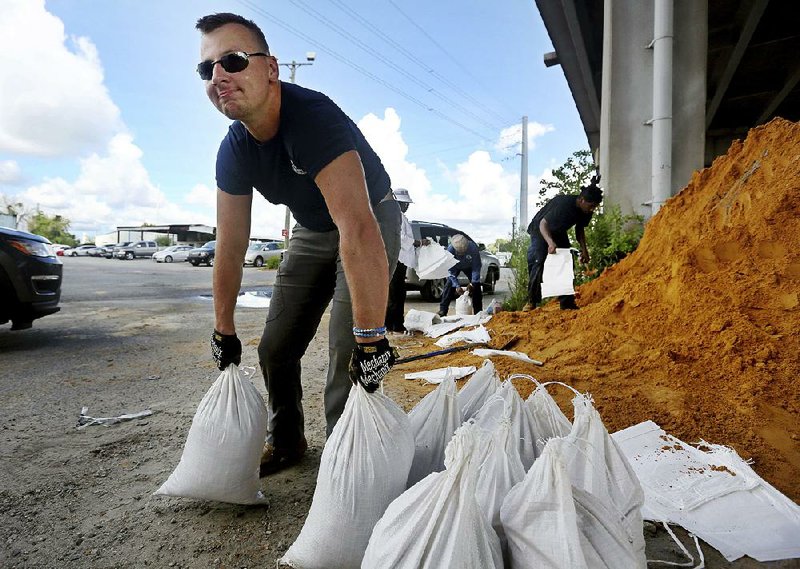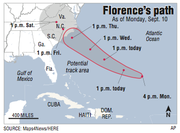RALEIGH, N.C. -- Florence developed into a Category 4 hurricane Monday as it closed in on North and South Carolina, carrying winds up to 140 mph and water that forecasters say could wreak havoc over a wide stretch of the eastern United States later this week.
Communities along a stretch of coastline that's vulnerable to rising sea levels prepared to evacuate the storm, which forecasters expect to be close to Category 5 strength by today. The South Carolina governor ordered the state's entire coastline to be evacuated starting at noon today and predicted that 1 million people would flee. And Virginia's governor ordered a mandatory evacuation for some residents of low-lying coastal areas.
The National Hurricane Center said Monday the monster storm will be close to Category 5 strength by today. A Category 5 storm has the potential to cause catastrophic damage.
"The bottom line is that there is high confidence that Florence will be a large and extremely dangerous hurricane, regardless of its exact intensity," the hurricane center said. Florence was a Category 4 storm late afternoon Monday.
The storm's first effects were already apparent on barrier islands as dangerous rip currents hit beaches and seawater flowed over a state highway.
For many people, the challenge could be finding a safe refuge: If Florence slows to a crawl just off the coast, it could bring torrential rains to the Appalachian mountains and as far away as West Virginia, causing flash floods, mudslides and other dangerous conditions.
The storm's potential path also includes a half-dozen nuclear power plants, pits holding coal-ash and other industrial waste, and numerous hog farms that store animal waste in massive open-air lagoons.
Airlines, including American and Southwest, have started letting passengers change travel plans that take them into the hurricane's possible path.
National Hurricane Center Director Ken Graham warned that Florence was forecast to linger over the Carolinas once it reaches shore. People living well inland should prepare to lose power and endure flooding and other hazards, he warned.
Not only has the storm exploded in intensity, but its zone of hurricane-force winds approximately doubled in size Monday.
Computer-model forecasts generally project the storm to make landfall between northern South Carolina and North Carolina's Outer Banks as a Category 4 on Thursday, although shifts in the track are possible and storm impacts will expand great distances beyond where landfall occurs. Given the uncertainty and time it takes to evacuate, officials in North Carolina have issued mandatory evacuation orders for Dare County and Hatteras Island.
TRIPLE THREAT
The Hurricane Center is warning of an "extremely dangerous" triple threat in the Carolinas and Virginia:
• A "life-threatening storm surge" at the coast -- a rise in ocean water over normally dry land.
• "Life-threatening freshwater flooding from a prolonged and exceptionally heavy rainfall event" from the coast to interior sections.
• "Damaging hurricane-force winds" at the coast as well as some distance inland.
A warm ocean is the fuel that powers hurricanes, and Florence will be moving over waters where temperatures are peaking near 85 degrees, hurricane specialist Eric Blake wrote. And with little wind shear to pull the storm apart, Florence's hurricane wind field was expected to expand over the coming days, increasing its storm surge and inland wind threats.
At 10 p.m., the storm's center was located about 465 miles south-southeast of Bermuda and about 1,085 miles east-southeast of Cape Fear, N.C. Maximum sustained winds were clocked at 140 mph as it moved west-northwest at 13 mph.
The storm was more than 400 miles wide early Monday, according to a National Weather Service tweet. A Category 4 hurricane has winds in the 130 to 156 mph range, said the National Hurricane Center. In such winds, downed trees and power failures are common, and well-built homes can suffer heavy damage, the center said.
Two other storms were spinning in the Atlantic. Hurricane Isaac was expected to lose strength as it reaches the Caribbean, and Helene, much farther out to sea, may veer northward into the open ocean as the 2018 hurricane season reaches its peak.
In the Pacific, Hurricane Olivia triggered warnings for multiple Hawaiian islands as it blew west toward an arrival over the state as soon as late today or early Wednesday.
Preparations for Florence were intensifying up and down the densely populated coast. Since reliable record-keeping began more than 150 years ago, North Carolina has been hit by only one Category 4 hurricane: Hazel, with 130 mph winds, in 1954.
'GET OUT OF TOWN'
The parking lot has been full for three days at the Ace Hardware store in coastal Calabash, N.C., where manager Tom Roberts said he sold 150 gas cans in two hours Monday, along with generators, plywood, rope, manual can openers, sand bags and a plethora of other items.
"I've been doing this since 1983," Roberts said as he completed an order for another 18-wheeler full of supplies. "This is the craziest one."
Many newcomers have moved to the coast in the nearly 19 years since the last strong hurricane -- Floyd -- threatened the area. Roberts said he's telling them to get out of town.
"I'm telling them to go inland, but I'm worried about the rain and tornadoes too," Roberts said.
Several meteorologists said Florence could do what Hurricane Harvey did last year over Texas, dumping days of rain, although not quite as bad.
"I think this is very Harvey-esque," said University of Miami hurricane expert Brian McNoldy. "Normally, a landfalling tropical cyclone just keeps on going inland, gradually dissipating and raining itself out. But on rare occasions, the steering patterns can line up such that a storm slips into a dead zone between troughs and ridges."
On North Carolina's Outer Banks, Dawn Farrow Taylor, 50, was gathering photos and important documents and filling prescriptions Monday before heading inland. She grew up on the island chain, and says this will be only the second time she's evacuated.
"I don't think many of us have ever been through a Category 4. And out here we're so fragile. We're just a strip of land -- we're a barrier island," she said.
In the village of Buxton, Liz Browning Fox plans to ride the storm out in her house on top of a ridge. She believes her home, built in 2009, will be secure, but it's hard to foresee all potential hazards.
"You never know, there could be tree missiles coming from any direction," she said. "There is no way to be completely safe."
Among those taking early action as the storm nears is the University of North Carolina Wilmington, which canceled classes and issued a "voluntary evacuation" over the weekend, according to the Wilmington Star.
The NC Ferry Division announced Sunday that it was canceling some ferries to Hatteras and Ocracoke islands "due to preparation for possible severe weather."
EVACUATION ORDERS
In announcing his evacuation order, South Carolina Gov. Henry McMaster said an estimated 1 million people would be fleeing the coast. Eastbound lanes of Interstate 26 heading into Charleston and U.S. 501 heading into Myrtle Beach will be reversed when the order takes effect. Two others may also be reversed if needed. Schools and state offices in about half the state would be closed starting today, the governor said.
An evacuation order from Virginia Gov. Ralph Northam applies to about 245,000 people, including parts of the Hampton Roads area and Eastern Shore.
North Carolina Gov. Roy Cooper said his state was "in the bullseye" of the storm and urged people to "get ready now."
Cooper's office said Bertie, Brunswick, Currituck, Dare, Hyde, New Hanover and Onslow have ordered evacuations. The statement said more evacuation orders are expected today.
President Donald Trump, who was criticized for his response to the crisis in Puerto Rico after Hurricane Maria last year, signaled that he was on top of this storm in a pair of tweets Monday.
"To the incredible citizens of North Carolina, South Carolina and the entire East Coast -- the storm looks very bad! Please take all necessary precautions. We have already began mobilizing our assets to respond accordingly, and we are here for you!" Trump wrote.
Trump later Monday approved North Carolina's emergency declaration.
In a statement Monday night, the administration said the president's action "authorizes the Department of Homeland Security, Federal Emergency Management Agency (FEMA), to coordinate all disaster relief efforts."
In 1989, Hurricane Hugo grew to a Category 4 storm before coming ashore near Charleston, S.C., where it caused about $14.1 billion in damage when adjusted for inflation, making it the 13th costliest U.S. storm, according to Hurricane Center records. Hugo killed 49 people in the U.S. and across the Caribbean.
Florence could almost double that price tag with total losses reaching $27 billion, said Chuck Watson, a disaster modeler with Enki Research in Savannah, Ga. It would be the eighth costliest storm in U.S. history.
Information for this article was contributed by Jonathan Drew, Jennifer Kay, Jeffrey Collins, Meg Kinnard, Seth Borenstein and Jeff Martin of The Associated Press; by Mark Price of The Charlotte Observer; by Brian McNoldy and Jason Samenow of The Washington Post; by Brian K. Sullivan, Chris Dolmetsch, Alex Longley and Simon Casey of Bloomberg News; and by Richard Fausset of The New York Times.
A Section on 09/11/2018



